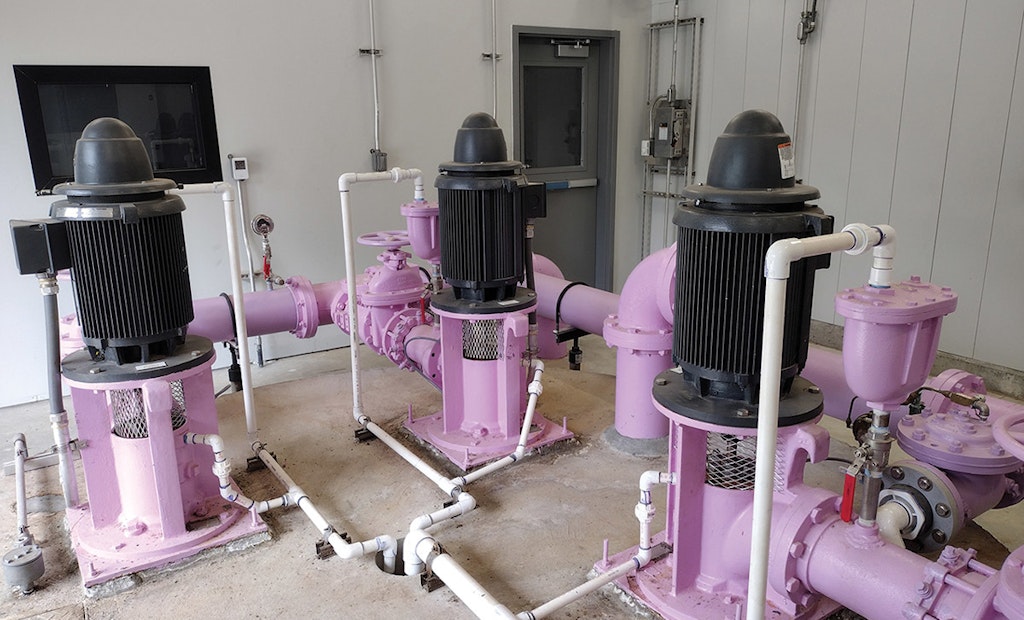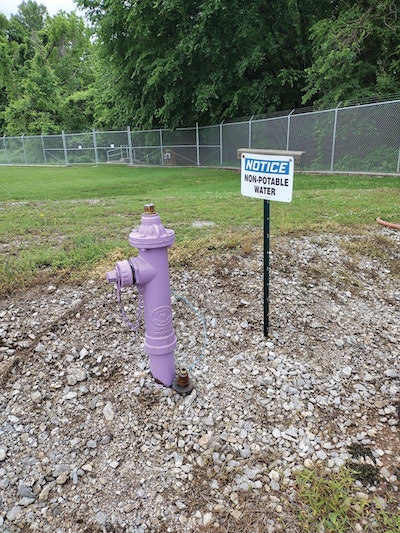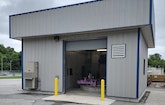
Inside the pump station that handles effluent for reuse. The plumbing is painted in the signature purple for recycled water.
Interested in Recovery/Reuse?
Get Recovery/Reuse articles, news and videos right in your inbox! Sign up now.
Recovery/Reuse + Get AlertsUsing recycled effluent instead of potable water for in-plant processes saves thousands of dollars every month at a wastewater treatment plant in Broken Arrow, Oklahoma.
Not long ago, the Lynn Lane Wastewater Treatment Plant was the city’s largest water consumer. Potable water was used for all the water-reclamation processes as well as cleaning at the plant (5-6 mgd average flow).
“We were pulling in 100,000 to over 200,000 gpd of drinking water to run all of our processes,” says David Handy, facility manager. “That includes our washdown areas, water we use in the headworks for screening and grit removal, and chlorine disinfection.”
MEANINGFUL SAVINGS
The reuse system takes effluent just before discharge to a tributary of the Arkansas River and puts it into a wet well that pumps it throughout the plant in purple pipes. The potable waterline was severed ahead of the headworks, so the potable water goes only to the administration building and eyewash stations in the plant.
The project was executed as a part of a $3 million clarifier rehabilitation project. Handy estimates that the plumbing and pumps to use treated effluent as process and washdown water represented about one third of the cost. He considers that a good financial investment.
“We went online in October, 2020,” Handy says. “For 2021 our saving was $55,000. We seem to be saving about $6,000 a month.” The reuse project also preserves water and the resources required to treat it, although Broken Arrow does not usually face water shortages.
Before installation of purple pipes throughout the plant, the only reuse water at the plant was for irrigation at two nearby golf courses, which pump water directly from the chlorine contact chamber to their holding pond.
DISINFECTION CHANGE
The savings from the reuse project will be tempered somewhat by another project coming online this year: conversion from chlorine disinfection to in-pipe UV (Wedeco). The new system will require less process water than the chlorine system, which uses chlorine gas and sodium hypochlorite.
One reason for the switch is the potential hazard of storing and handling chlorine gas. A residential development is fairly close to the treatment plant. “My risk management plan is about 16 binders,” Handy says. “I would dearly love to reduce that to two or three.”
Even with UV disinfection, chlorine handling will not be eliminated: The plant will still chlorinate the water sent to the golf courses. “We’ll still have sodium hypochlorite, strictly for the reuse season, May through September,” Handy says. “We are required to have chlorine disinfection for the golf courses.”
REDUCING ODOR
Being close to homes played a role in another recent project — redesigning the headworks. Odor problems at the plant were the subject of a study in 2002 indicating that the main sources were two open screw pumps and an aerated grit chamber. A new system went online in 2019.
“We eliminated those open screw pumps that were just splashing water and breaking down all the organics,” Handy says. “We removed them, those two structures and an aerated grit chamber as well. We demolished them and built one brand new headworks facility. We scrub the air inside the headworks and run it through a biofilter designed by HDR with composite media.”
The new headworks has a perforated plate screen with 6 mm holes (SAVECO / Enviro-Care). From there the influent goes into a pair of wet wells with 24-inch and 14-inch submersible pumps (KSB) that move the water into the grit removal system (Hydro International). From there the wastewater travels to a splitter box where the influent is mixed with return activated sludge and into two oxidation ditches.
UNUSUAL FREEZE-UP
The new system has worked well. Air is vacuumed from the building structure, moistened through a misting waterline, and then blown into the biofilter media through a header system.
“We’ve had no complaints except for one in February 2021, when we had a hard freeze,” says Handy. “The misting line froze. We had heat tapes on it, and they were working, but it wasn’t enough.”
That was unusual weather for the Southwest — it snowed as far south as Houston — and as unlikely as it is to be repeated, the plant staff has developed a plan to cope with it. “We just adapted new procedures,” Handy says. “If it gets that low again, we’ll shut down and drain the misting line and go to a manual mode where we’ll hand-water the bed every day or two.”
After the misting line froze and burst. It was replaced with a more durable HDPE pipe in place of PVC. That one pipe failure underscores how effective the system is when everything is working.
“The biofilter has been doing its job,” Handy says. “That’s the first thing everybody notices when they come into the plant: There’s no smell. Our operators do a fantastic job of keeping this plant up to date and doing all the things in the daily operations to keep it efficient.”







